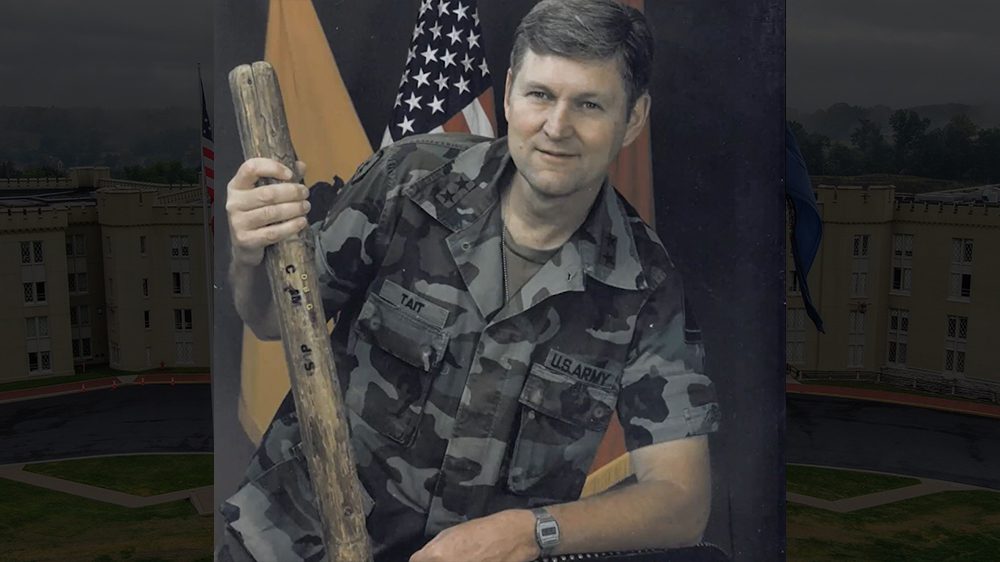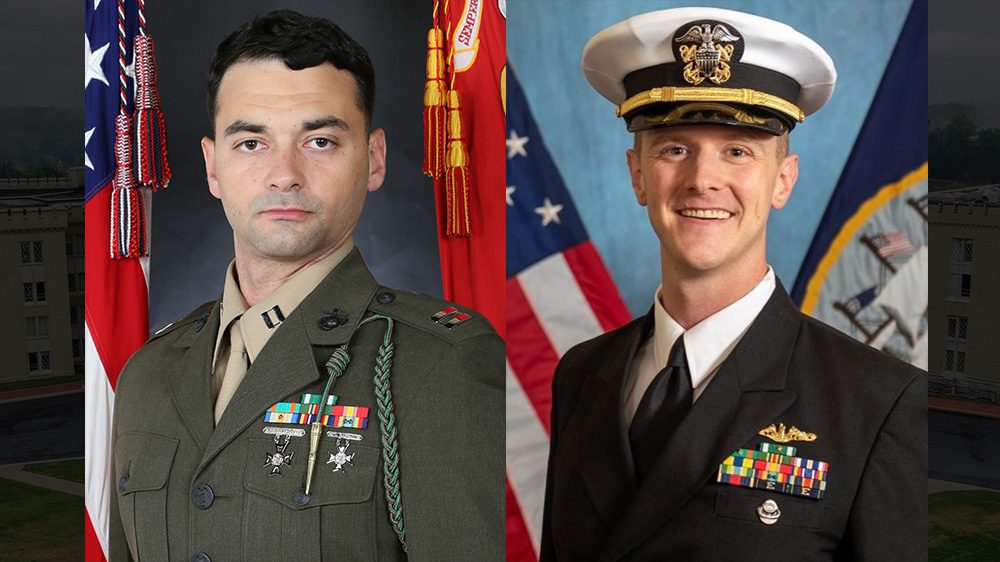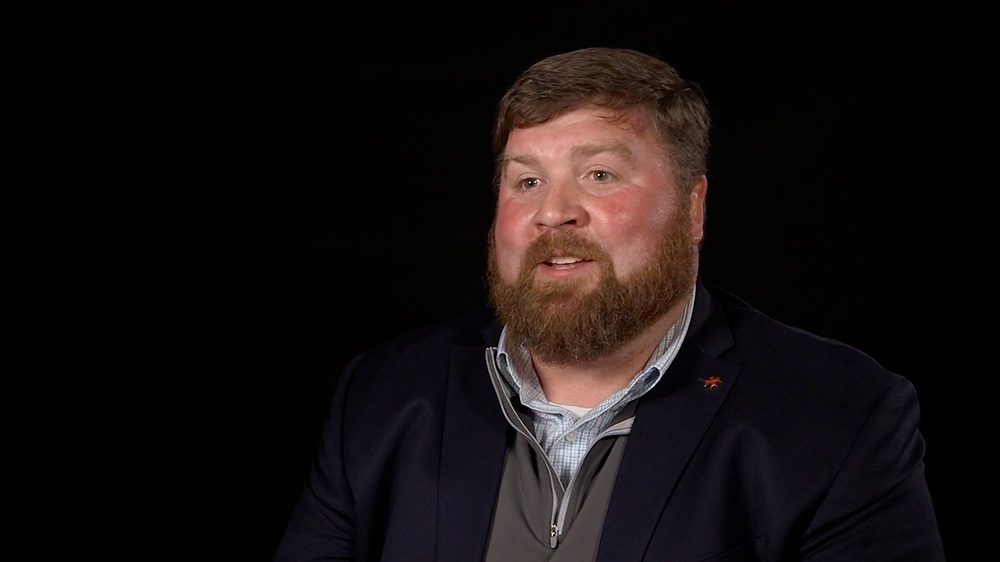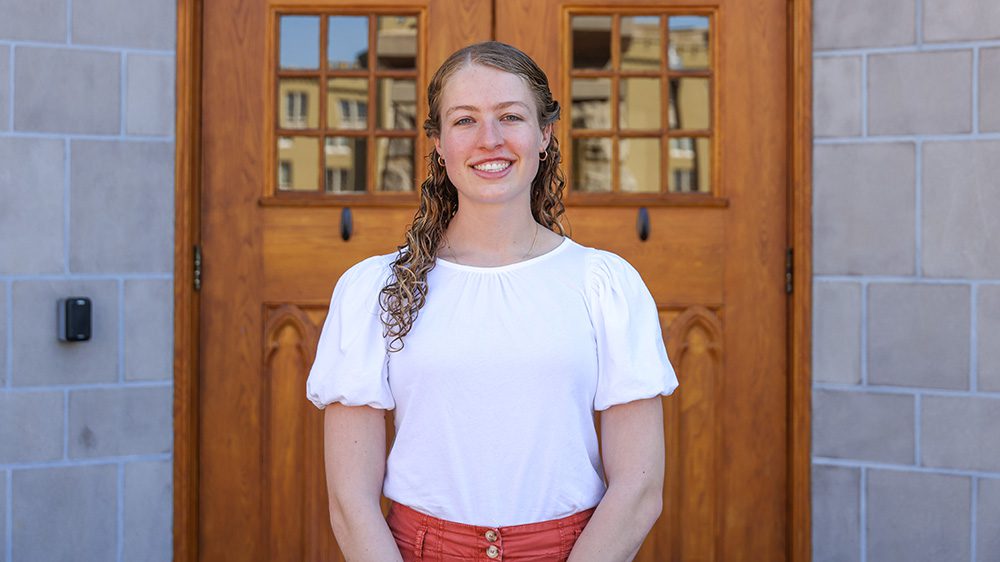When you met Maj. Gen. Tom Tait ’55, you didn’t forget him. His 6’6” height was intimidating, or maybe it was his booming voice, but the fence post he carried—his “big stick”—was the clincher. He was an old breed of soldier who seldom asked permission to do things and instead focused on getting the job done. Many remember him as a fixture at VMI events in his later years when he lived in Lexington.
Tait was born in Glen Cove, New York, in 1932 and was raised on Long Island with his younger sister. His mother was a housewife from Sweden, and his father was a bank guard and former Marine. By his own admission, he didn’t excel as an athlete or as a student in high school. He went to VMI because the price of $1,500 included everything: Room, board, meals, and uniforms. The basketball team wasn’t very good, and everybody was a walk-on back then, as there were no scholarships. Tait played all four years. One year, with an 11-12 record, the VMI basketball team went to the Southern Conference tournament for the first time in many years. The alumni were so happy that they gave the team gold-plated basketballs. Tait said he wasn’t a great ball player but had a decent hook shot.
Academically, Tait was a civil engineering major. He admired Maj. Gen. James “Jimmy” Morgan ’45, Col. Jim McDonough ’42, and Col. Lee Nichols ’44, who were professors in the engineering department, as well as Col. Bill Byers ’43, a professor in the English department who helped him through. Lt. Col. Henry C. Kerlin, Class of 1930, was commandant at the time and was not a fan of Tait. The basketball coach gave Tait a pair of clean white socks after each practice that Tait liked to wear. For repeatedly wearing white socks as a cadet, the commandant awarded Tait a 10-demerit, six-week confinement with 30 penalty tours, known as a 10-6-30, which Tait thought was excessive. He would be a private all four years at VMI and, in his words, was “deficient in conduct” for three of his four years, excluding his rat year.
Surprisingly, Tait didn’t want to go into the military but was required to take a commission in those days, and he asked for the U.S. Army’s Armor branch, which he received. On his way to Germany, he married his VMI sweetheart, Caroline Wood Gauss, in June 1956 in New York City. Together, they produced four daughters, all of whom went to college, as he would proudly recount. The newlyweds were stationed in Mainz, and Tait’s unit had M48A1 tanks. This was 11 years after World War II, and cities still had substantial visible war damage.
Tait completed his active duty obligation in 1957 and returned to civilian life as an engineer. For the next two years, life was pretty dull, but he enjoyed his time as a weekend warrior in the U.S. Army Reserve. His company commander suggested he reapply to return to active duty, and Tait did. To his surprise, he received a regular Army commission in the Ordnance Corps.
For the next two and a half years, he was a proof officer at Aberdeen Proving Ground, Maryland. Among other things, Tait tested the Sergeant Missile System and the original COFRAM ammunition, which released little bomblets. By 1961, he put in a branch transfer back to Armor, but the Ordnance commandant wanted to keep him and sat on his request for six months. Tait pushed for the transfer, and in February 1962, Tait received a branch transfer to Armor. He was assigned to command Company A, 2nd Battalion, 1st Training Brigade at Fort Knox, Kentucky. Promotion to captain soon followed for Tait, as did a trip to the Armor Advanced Course.
By mid-1963, Tait was sent to Korea, where he commanded Company B, 2nd Battalion, 15th Armor, which was part of the 1st Cavalry Division. As captain, Tait was the club officer and battalion S4 in addition to being a company commander. He recalled being sent to the Demilitarized Zone, or DMZ, to test-fire the 26 tanks that were dug in there facing North Korea. The tanks had no engines and were situated like “pillboxes.” With a little work, all 26 were fired. Many cold warriors remember getting up in the wee hours and deploying all the vehicles and equipment to a General Defense Plan position. Tait worked hard at this in Korea, and during one of the monthly timed tests, his tank company moved out of their compound in less than 5 minutes. I asked how that was possible, and Tait said that soldiers kept their duffle bags in the tanks; when an alert sounded, the tank loader went to the arms room and picked up all the handheld weapons in a sandbag while the rest of the tank crew fired up their tank. The timed portion ended when the last vehicle exited the compound.
After Korea, Tait was assigned one year at the Staunton Military Academy. This was a lousy assignment for Tait, as he had issues with the way the school was run and the people who owned it. He used a connection to get back to Germany, where he was assigned to the G2, V Corps as a border operations officer. Walking the border paid off years later when he became Corps G3. Tait was promoted to major during this time.
Germany was a lot different this tour as a fence had been erected across both Germany and Czechoslovakia between the east and west. Observation posts extended along the border that corps units patrolled. There were some shooting incidents as East Germans tried to escape over the border and were often shot.
All four of Tait’s girls had been born by then, and life was good. The girls went to schools in Frankfurt, and the family lived in a four-bedroom apartment on Platenstrasse. America’s relationship with Germany was good as most wanted Americans there to deter a Russian attack. Meanwhile, many officers were being pulled from Europe and sent to Vietnam. Tait’s turn came in 1968. The family went to Port Washington, New York, near his parents, and Tait boarded a plane to Tan Son Nhut Air Base, Saigon.
Tait arrived around Feb. 2–3, 1968, just days after the Tet Offensive in the Vietnam War. Tan Son Nhut was in shambles after the Tet Offensive military campaign. Tait used a connection to get assigned to the 25th Infantry Division at Cu Chi, 25 kilometers northwest of Tan Son Nhut. Cu Chi was also severely damaged during the Tet Offensive. The 3rd Squadron, 4th Cavalry Regiment was Tait’s destination, where he was assigned as battalion executive officer under Lt. Col. Glenn K. Otis, who later became a general. Otis had just earned a Distinguished Service Cross for his actions in retaking Tan Son Nhut.
In Vietnam, Tait managed administration and logistics, which he disliked, but he tackled it with his usual energy. Maintenance was “pretty shoddy,” so he focused there. Maintenance included helicopters, and the airfield was a huge enemy target. They experienced regular mortar and rocket attacks. The book, The Tunnels of Cu Chi, further explains the distressing situation Tait braved as he maintained the area. The tunnels the book’s title refers to were started in the late 1940s during fighting between Vietnamese and French forces and were expanded in the early 1960s. The tunnels ran upwards of 250 kilometers, or 155 miles, around Cu Chi. The enemy could pop up anywhere out of the ground, and “every once in a while, bullets would fly.”
A couple of weeks after Tait joined the cavalry, Otis went on leave for two weeks and left Tait in charge. Within 45 minutes of Otis’s departure, a “hell of a fight” occurred. A cavalry troop was patrolling, and the lead platoon was ambushed. Two men were killed, and the platoon leader was severely wounded. This was Tait’s first battle. Afterward, he received a visit from the division commander, who wasn’t happy as some of the cavalry’s rounds had hit a hospital. Tait survived the day but learned some lessons. After that, every day was another fight, and he lost a few more men.
Another night, Otis was out on a night operation. Tait was in charge, and he had the men dig in, which they hated. He was located on a chair between two M577 tracks looking at a map board. It was around midnight, and Tait fell asleep in the chair when rocket-propelled grenades, or RPGs, came in and sent fragments everywhere. Those who were dug in were safe, but Tait was blown off his chair and received a minor cut.
Triple-canopy jungle in Tait’s area of operations was another challenge because it wasn’t ideal for tanks and tracks. The men came under fire and were wounded, and air evacuation was near impossible with the lack of landing zones. On April 20, 1969, Tait led a single tank and a couple of squads of infantry into the town of Dau Tieng, where the enemy occupied a compound with a series of bunkers. All but one bunker capitulated. While Tait was supervising the operation, a grenade landed nearby, knocking off his helmet and causing him to lose his rifle. He didn’t lose consciousness and continued to manage the situation. At some point—after realizing he was wounded—Tait passed command over to another officer and went to the aid station. He was then evacuated to Saigon by helicopter.
Once at the hospital, he went into the operating room immediately. A nurse told him he looked “like a pin cushion.” Grenade shrapnel had done its best work, leaving his left leg severely damaged and in a cast. He underwent 12 operations in a row. He was then sent to convalesce near his home in St. Albans Hospital, Queens, New York. He was there through August 1969.
The Army didn’t wait long to return Tait to duty, and orders came for the 3rd Cavalry Regiment, Fort Lewis, Washington, which turned out to be a one-year tour for the Taits. Tait drove cross-country with Caroline, the four girls, a collie, and a hamster. Tait was assigned as a squadron executive officer and spent time training National Guard units who were headed to Vietnam. He built a Vietnamese village as part of the training to better prepare soldiers.
Tait learned that many of his soldiers were draftees whose pay could not support their families. When he asked about food stamps, he was told by higher headquarters that the Army takes care of its own, but that wasn’t true. So, Tait loaded up his needy soldiers, with the squadron sergeant major’s help, and drove them to downtown Tacoma, where they were issued food stamps. He paid a price for doing this, but it was worth it.
Tait’s next stop was the Air Command and Staff College in 1970. The year at ACSC was relaxed for Tait, but this was not the case for his Air Force counterparts, who feared being counseled if they failed to stand high in their class. For the final exam, a friend gave him notes to help him study. In the middle of the final, Tait realized that the study notes were all the test questions, and he told his seminar leader that he refused to take the test. His leader told him he must complete the test, so Tait demanded to see the school commandant. The commandant ordered him to take the test and promised to investigate. The fellow who made the test and gave out the notes admitted he made it so everyone would do well. The VMI Honor Code stuck with Tait.
For the next three years, Tait drove a desk at the Armor branch in Washington, D.C. His career continued to progress, as he was selected for squadron command with the 1st Squadron, 3rd Cavalry at Fort Bliss, Texas. He learned to fight in the desert and overcome a significant inherited maintenance problem. His unit had M551 Sheridan tanks, M113 and M114 armored personnel carriers, and a howitzer battery with M109s. Tait demanded his areas be kept very clean and that every soldier in the squadron participate in maintenance training. AWOLs, or soldiers who were absent without leave, were a big problem at the time, and Tait was recognized for his low AWOL rate. Keeping his soldiers busy and challenged was Tait’s solution for these low AWOL numbers; he also kept his men in the field training as much as possible.
Next, Tait spent a year in Washington with the Army Concept Analysis Agency, which wasn’t exciting for him, but it was followed by a year at the Army War College. There, he reunited with fellow armor officer “Bullet Bob” Wagner ’57. Because this was the Cold War era, Tait also got to work on a study concerning the outcomes if Russians were to attack NATO through the North Cape of Norway. Tait went to Sweden on a side trip and met a host of first and second cousins from his mother’s family, which was a thrill. Following the Army War College, he went back to the 3rd Cavalry Regiment at Fort Bliss, Texas, as a regimental executive officer, and he tested the first M1 tanks. The new tanks had many problems, and Tait helped map out the fixes. His time at Fort Bliss was short, as he came out on the brigade command list and moved to Germany for the third time as a commander of the 3rd Brigade, 8th Infantry Division in Mannheim.
As he had in the past, Tait kept his brigade in the field, spending a lot of time at the brigade’s General Defense Plan location. This is where he would go if the Russians attacked. Always the thinker, Tait moved his GDP line forward, which upset the Germans who were to defend his flank. He showed them why he moved to a more defensible position. Over time, the Germans appreciated his planning. It was at this time that Tait started carrying a German fence post, which he became famous for and which now resides in the VMI Museum. When German reporters later asked why he carried the fence post, he chuckled, “It was for beating off the women.”
Tait was selected to be the V Corps G3 operations officer. This was the plum job after a brigade command, and Tait would work for Lt. Gen. Paul Williams ’51. Williams would promote Tait to brigadier general Sept. 1, 1983. Tait had learned to focus on his go-to-war General Defense Plan while in command and did the same as Corps G3 very successfully.
Soon after his promotion to brigadier general, Tait was sent to the 3rd Infantry Division in Schweinfurt, Germany, as the assistant division commander. In this position, he replaced Wagner ’57. The two of them trooped the line of soldiers as the band played the VMI Spirit. Tait knew to look for places where few generals ventured. In an area behind Ledward Barracks, he found abandoned old military vehicles and a lot of blank rifle ammo. He took all the local command sergeant majors on a tour and ordered them to clean up the area and take the old vehicles to the German trash dump. The Army Criminal Investigation Division, or CID, told him he couldn’t dispose of the vehicles because they were government property. Tait told them that he was in charge and he could—and he did.
The Tait family’s time in Schweinfurt was short, just a year, as Gen. John R. Galvin, the supreme Allied commander, Europe, ordered Tait to take over the 2nd Armored Division (Forward) in just four days. Tait called the SACEUR to ask to finish his current tour, but he was told to “Shut up and go!” The tour in Garlstedt turned out to be one of the best of his career. He was a long way from his boss, and being isolated had its benefits. Tait would defend north Germany in conjunction with a German corps in the event of war until help arrived. In the meantime, Tait had to deal with peace demonstrations. He attended a lot of German functions and often came in battle dress uniform, or BDUs. This excited the liberal German “Greens,” who vilified Tait as the “killer general.”
Tait came out on the two-star list and was assigned to Washington, D.C., as the director of training for the Army. Tait’s old friend and former boss, Gen. Carl Vuono, took over as Army chief of staff shortly afterward and ordered Tait to Fort Knox, Kentucky, where he would take over the Armor School. This was a dream come true for an Armor/Cavalry officer like Tait. He would stay there from 1986–89. As he had in the past, Tait, a hands-on man, realized early on that Fort Knox needed a lot of money to modernize. This realization took him into the world of politics, and soon he had a host of congressional and state officials visiting. Tait showed them how much money Fort Knox and the other military installations brought to the state of Kentucky. Senators Mitch McConnell and Paul D. Bunning were on board, and the money came to Fort Knox.
As his tour neared a close, Tait was told by the V Corps commander in Germany that he would be his successor with a promotion to three stars, but the Goldwater-Nichols Act, which reworked the command structure of the U.S. miliary, put a stop to that. The secretary of defense told the secretary of the Army that Tait needed a joint assignment before he could be promoted in accordance with the 1986 law. The promotion was off the table. Commanding Fort Knox would be the highlight of Tait’s career.
Tait wasn’t finished yet, however. In fall 1989, he moved to take over temporarily as acting 2nd Army commander—just in time for Hurricane Hugo. Tait was stationed in Charleston, South Carolina, and found both state and Federal Emergency Management Agency people were ill-prepared. In his usual take-charge way, Tait took over, causing the governor of South Carolina to call then-President George H.W. Bush and ask whether he or Tait was in charge. Tait was, and he was known, as “Commander-in-Chief Hugo” or “CINC Hugo.”
Desert Storm came next. The I Corps commander at Fort Lewis deployed to war, and Tait took over as corps commander for five months. As usual, Tait was a whirlwind with the brief time he had. His corps was now the nation’s only contingency corps should problems develop in other parts of the world, and Tait would be ready.
Retirement was overdue for Tait, but his old friend and now Army chief of staff, Gordon Sullivan, asked him to stay on and write the after-action report for Desert Storm. It took nearly six months, and he produced a 1,000-page document. Then, Tait retired with 35 years of service, two Army Distinguished Service Medals, two Legions of Merit, a Bronze Star, and a Purple Heart, among other awards.
Caroline Tait had loyally shared in all of Tait’s military career, but she was not to enjoy her husband’s retirement for long, as her battle with cancer ended in 1997. She was truly a saint for raising the four girls, often in Tait’s absence. Tait’s girls remained close to their dad and had families of their own. Tait was very attached to his grandchildren, telling them stories, taking them to VMI parades, and always to VMI sporting events. Tait would later marry Margaret Ann Jones, and together they enjoyed retirement in Lexington at their home called “Parade Rest.” Many would see his “Viking 6” license plate recalling his call sign from the good old days. Tait had a very successful post-Army career as a consultant. He worked with a bevy of American defense contractors in addition to Swedish companies, which he especially enjoyed.
Tait’s friends remember his “no-nonsense approach to problem-solving, a power-down approach to leadership” and a great sense of humor. Tait passed away Nov. 30, 2020, and is buried in Arlington National Cemetery next to his wife, Caroline. When Tait acknowledged someone doing a good job, he said, “good on ya,” and the soldiers responded with, “Treat ’em rough.” “Treat ’em Rough” is on the back of Tait’s monument in Arlington. Tait represented VMI very well.
Author’s Note: This presentation is based on two interviews I did with Gen. Tait in 2006 and 2007. Thanks to Tait’s family members for sharing photos.
Editor’s Note: Jim Dittrich ’76 is the VMI Alumni Association historian. He lives in Williams-Junction, Arkansas, near Perryville.
Sources:
- Tate Memoirs, VMI Archives
- History.com, 2 Aug 2011, Cu Chi Tunnels
- AlleghanyJournal.com, Tait Obituary, December 2020
- Lexington New Gazette.com, 30 Nov 2020
-
Jim Dittrich '76 Alumni Association Historian




